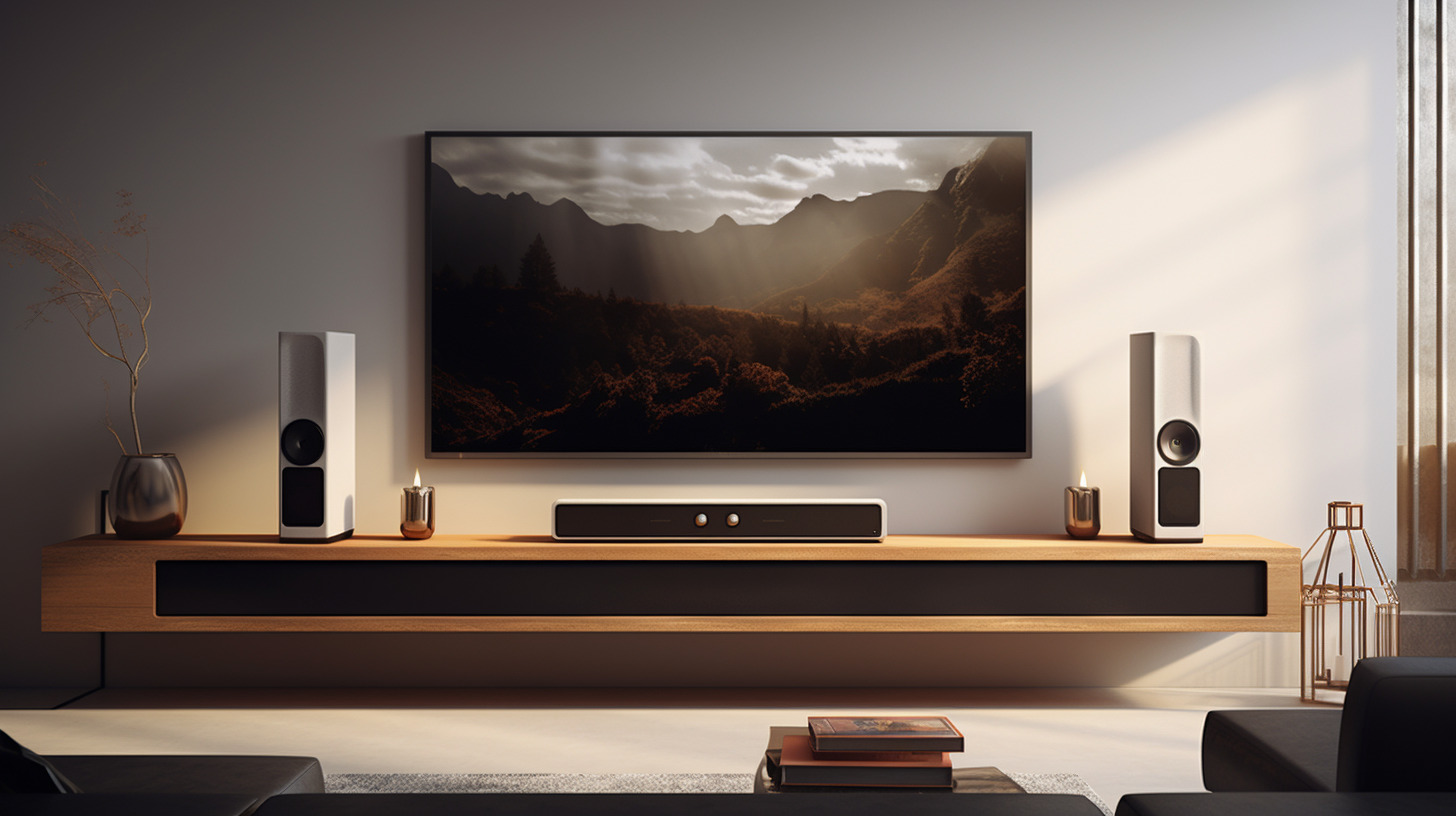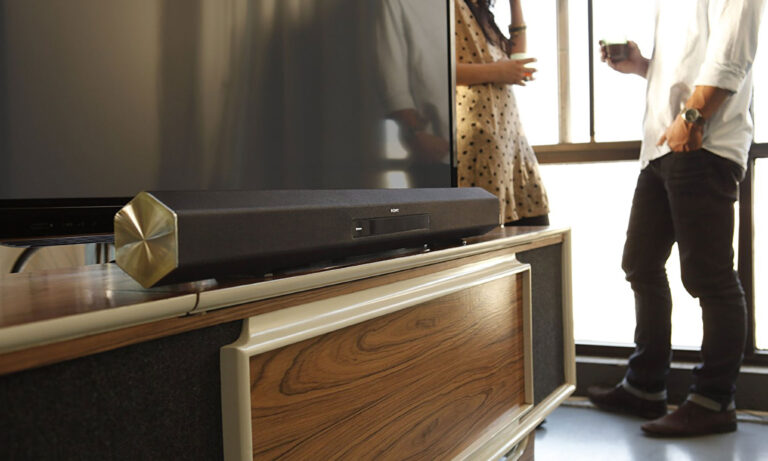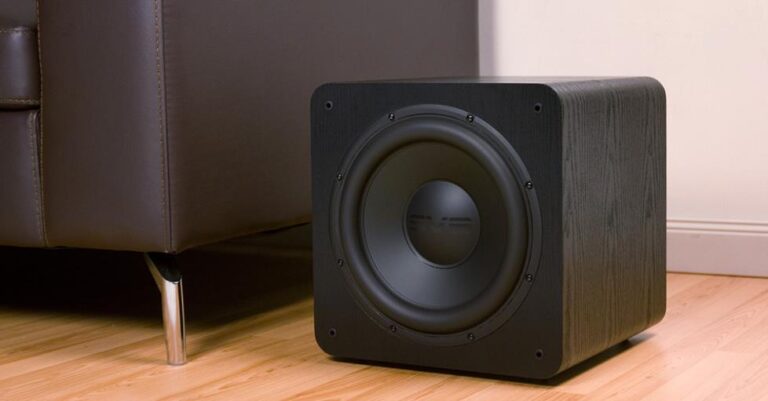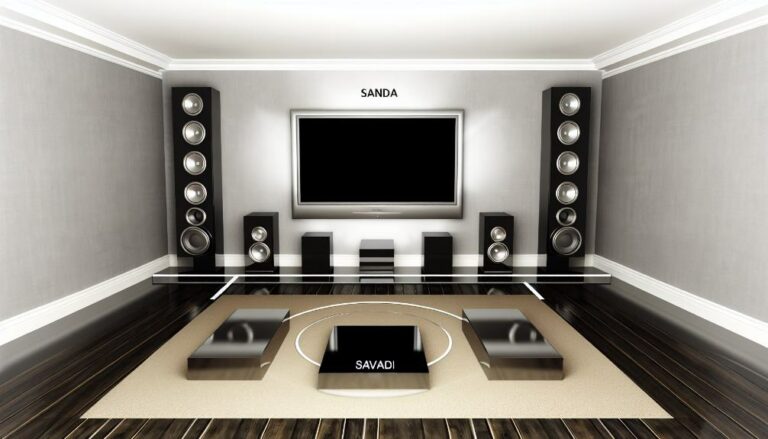Looking to enhance your home theater experience? Dive into the world of soundbar HDMI ARC connectivity options. Get ready to unlock a whole new level of audio performance.
This article will guide you through 10 different ways to connect your soundbar using HDMI ARC. From understanding the differences between HDMI ARC and HDMI eARC to troubleshooting common connection issues, we’ve got you covered.
Discover the power of immersive sound and high-quality video with HDMI ARC. Get ready to elevate your entertainment setup.
Key Takeaways
- HDMI ARC simplifies the setup process by connecting the soundbar to the TV with just one cable.
- HDMI eARC offers higher bandwidth and supports lossless audio formats.
- Popular soundbar brands like Samsung, Sony, LG, Bose, and Yamaha offer HDMI ARC support.
- HDMI ARC offers better audio quality than Bluetooth.
HDMI ARC: What Is It and How Does It Work
If you’re wondering how HDMI ARC works, let’s break it down for you. HDMI ARC stands for High-Definition Multimedia Interface Audio Return Channel. It’s a feature found in newer TVs and soundbars that allows for two-way communication between the devices through a single HDMI cable. This means that you can connect your soundbar to your TV using just one cable, simplifying the setup process.
One of the advantages of HDMI ARC over optical connections is that it supports higher audio formats, such as Dolby TrueHD and DTS-HD Master Audio. This means that you can enjoy superior sound quality when watching movies or listening to music.
However, like any technology, HDMI ARC can sometimes encounter issues. If you experience any problems, here are a few troubleshooting tips: make sure that both your TV and soundbar support HDMI ARC, check the HDMI cables for any damage or loose connections, and ensure that the correct input and output settings are selected on both devices.
HDMI ARC vs HDMI eARC: Understanding the Differences
First, let’s understand the key differences between HDMI ARC and HDMI eARC. Here’s a quick rundown to help you make an informed decision:
- Performance Differences: HDMI eARC (Enhanced Audio Return Channel) offers higher bandwidth and supports lossless audio formats like Dolby TrueHD and DTS-HD Master Audio. On the other hand, HDMI ARC (Audio Return Channel) has limited bandwidth and can only transmit compressed audio formats like Dolby Digital and DTS.
- Future Compatibility: HDMI eARC is the latest version and provides better future-proofing. It supports advanced audio formats and allows for firmware updates, ensuring compatibility with upcoming technologies. HDMI ARC, being an older version, may not have these capabilities.
- Audio Quality: With HDMI eARC, you can enjoy improved audio quality due to the support for lossless audio formats. This means you’ll get more detailed and immersive sound compared to HDMI ARC.
- Compatibility: HDMI ARC is more widely available and compatible with most devices, including older TVs and soundbars. HDMI eARC, on the other hand, is relatively new and may not be available on all devices.
Understanding these differences will help you choose the right HDMI connectivity option for your soundbar setup, considering both performance and future compatibility.
Compatible Soundbars: Which Models Support HDMI ARC
Check if your soundbar model supports HDMI ARC before attempting to connect it to your TV. Not all soundbars are compatible with HDMI ARC, so it’s essential to verify the specifications of your soundbar.
Many popular soundbar brands offer models that support HDMI ARC, including Samsung, Sony, LG, Bose, and Yamaha. These soundbars are designed to seamlessly connect to your TV using the HDMI ARC port, allowing you to enjoy high-quality audio and control the soundbar with your TV remote.
However, if you encounter any issues during the setup process, such as no sound or intermittent audio, it’s recommended to troubleshoot the HDMI ARC connection. Refer to the soundbar’s user manual or contact the manufacturer for specific troubleshooting steps to resolve any HDMI ARC-related problems.
Connecting Soundbar to TV via HDMI ARC: Step-By-Step Guide
To connect your soundbar to your TV via HDMI ARC, follow these step-by-step instructions:
- Check your TV and soundbar compatibility: Ensure that both your TV and soundbar have HDMI ARC ports. Refer to the user manuals or product specifications for confirmation.
- Connect the HDMI cable: Take an HDMI cable and connect one end to the HDMI ARC port on your TV. Then, connect the other end to the HDMI ARC port on your soundbar.
- Enable HDMI ARC on your TV: Access the settings menu on your TV and navigate to the audio settings. Look for the HDMI ARC option and enable it.
- Troubleshoot any issues: If you’re not getting audio through the soundbar, check the HDMI ARC settings on both the TV and soundbar. Make sure the HDMI cable is securely connected and functioning properly. You can also try power cycling both devices by unplugging them for a few seconds and then plugging them back in.
Troubleshooting HDMI ARC Connection Issues
If you’re experiencing HDMI ARC connection issues with your soundbar, try adjusting the audio settings on both your TV and soundbar. Troubleshooting HDMI ARC connection issues can be frustrating, but there are common problems that can be easily resolved.
One common issue is an incorrect audio format setting. Make sure that both your TV and soundbar are set to the correct audio format, such as Dolby Digital or PCM.
Another common problem is a loose HDMI cable connection. Ensure that the HDMI cable is securely plugged into both the TV and soundbar.
Additionally, check if the HDMI ARC port on your TV is enabled in the settings menu.
HDMI ARC Vs Optical: Pros and Cons
There are two main connectivity options to consider when it comes to soundbars: HDMI ARC and optical. Each option has its own advantages and disadvantages, so it’s important to understand the pros and cons before making a decision.
Here are four key points to consider:
- Audio Latency Comparison: When comparing HDMI ARC and Bluetooth, HDMI ARC has a significant advantage in terms of audio latency. Bluetooth can introduce noticeable delays between the audio and video, while HDMI ARC provides a seamless synchronization between the soundbar and the TV.
- Compatibility with Older TVs: If you have an older TV that doesn’t support HDMI ARC, optical is the way to go. Optical connections are widely supported and can work with almost any TV, regardless of its age.
- Audio Quality: HDMI ARC supports higher audio formats such as Dolby Atmos and DTS:X, providing a more immersive and high-quality audio experience compared to optical.
- Ease of Use: HDMI ARC simplifies the setup process, as it allows for a single cable connection between the TV and the soundbar. Optical connections require an additional cable for the audio connection.
Consider these factors when choosing between HDMI ARC and optical connectivity options for your soundbar, ensuring compatibility and optimal audio performance for your setup.
HDMI ARC Vs Bluetooth: Which Is Better for Audio Quality
When it comes to audio quality, HDMI ARC offers better performance than Bluetooth.
HDMI ARC (Audio Return Channel) allows for high-quality audio transmission from your TV to the soundbar, ensuring a lossless and uncompressed signal. This means you can enjoy clearer and more detailed sound with better dynamics and depth.
On the other hand, Bluetooth is a wireless technology that compresses audio files to transmit them between devices. While Bluetooth is convenient for its wireless capabilities, it can result in a loss of audio quality due to compression. The audio may sound slightly compressed or less detailed compared to HDMI ARC.
Therefore, if you prioritize audio quality, HDMI ARC is the better option. However, Bluetooth can still be a suitable choice if convenience and portability are your main concerns.
HDMI ARC and Dolby Atmos: Exploring Immersive Sound Options
To experience immersive sound options with HDMI ARC, you can explore the compatibility of Dolby Atmos. Dolby Atmos is a revolutionary audio technology that creates a three-dimensional sound experience, making you feel like you’re in the middle of the action.
When it comes to soundbars, there are several options available to optimize your Dolby Atmos audio experience:
- Dolby Atmos-enabled soundbars: These soundbars come with built-in upward-firing speakers that bounce sound off the ceiling, creating the illusion of overhead audio.
- Soundbars with rear speakers: Some soundbars come with wireless rear speakers that provide a more immersive surround sound experience, enhancing the Dolby Atmos effect.
- Soundbars with virtualization technology: These soundbars use advanced algorithms to simulate the overhead audio effect of Dolby Atmos, even without dedicated upward-firing speakers.
- Soundbars with HDMI eARC (Enhanced Audio Return Channel): HDMI eARC allows for lossless audio transmission between your TV and soundbar, ensuring the highest quality Dolby Atmos sound.
HDMI ARC and 4K HDR: Ensuring High-Quality Video and Audio
If you want to ensure high-quality video and audio with HDMI ARC and 4K HDR, you should consider the following options.
First, it’s important to ensure that your soundbar is compatible with 4K HDR. Look for a soundbar that supports 4K HDR passthrough, which means it can pass the high-quality video signal from your source device, such as a Blu-ray player or gaming console, to your TV without any loss in quality.
Additionally, make sure to optimize the audio settings for HDMI ARC. This can be done by enabling the HDMI ARC feature on both your TV and soundbar and selecting the appropriate audio format, such as Dolby Digital or Dolby Atmos, depending on the capabilities of your soundbar.
HDMI ARC and CEC: Simplifying Control of Your Soundbar and TV
By utilizing HDMI ARC and CEC, you can simplify the control of your soundbar and TV. HDMI ARC (Audio Return Channel) allows for both audio and video to be transmitted through a single HDMI cable, eliminating the need for multiple cables and simplifying your setup. CEC (Consumer Electronics Control) enables your TV remote to control various devices, including your soundbar, with just one remote.
Here are some benefits of HDMI ARC and CEC:
- Single Remote Control: With CEC, you can use your TV remote to control your soundbar, eliminating the need for multiple remotes and making it easier to navigate between devices.
- Simplified Connection: HDMI ARC allows for a single cable connection between your TV and soundbar, reducing cable clutter and making installation hassle-free.
- Audio Return: HDMI ARC enables your TV to send audio signals back to the soundbar, allowing for a seamless audio experience without the need for additional audio cables.
- Troubleshooting Made Easy: If you encounter any issues, such as audio not playing through the soundbar, HDMI ARC troubleshooting can help identify and resolve the problem efficiently.




